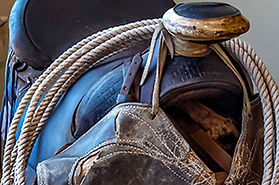
Exhibits

Bunk House
While the bunkhouse is now representative of a typical 1900s one-room house, the building originally served as the Adair Hospital’s segregated waiting room.

A Stitch In Time
View an array of sewing tools, including sewing machines, a spinning wheel, and dress forms, along with wedding dresses, and early 1900s fashion.

A Night Under The Stars
When away from ranch headquarters, whether on a cattle drive or during the seasonal roundup, cowboys often slept out under the stars. See a campground replete with cowboy teepee, bedroll, chuckbox, and more.

Doctor’s Office
Saints’ Roost Museum in Clarendon is housed in the former Adair Hospital, which was built in 1910 by JA Ranch cofounder and local philanthropist, Cornelia Adair, for use by the JA cowboys and their families. This exhibit includes a medicine cabinet, examining table, and surgical instrument table from the Adair Hospital.

Country Store
Take a step back in time to the days when merchandise was delivered to mercantile stores by horse-drawn wagon. Goods were brought from as far away as Dallas, Texas.
.jpg)
Chapel
Established as a prohibition community by Methodist clergyman, L.H. Carhart., Clarendon – nicknamed Saints’ Roost by local cowboys – was home to numerous churches. On display in the chapel is the pipe organ from the original First United Methodist Church, a stained glass hanging, hymnals, photographs, and more.

Good-Bye, Ma! Good-Bye, Pa! Good-Bye, Mule With Yer Old Hee-Haw!
A tribute to our nation’s Armed Services, view Saints’ Roost Museum’s Military Recruitment Memorabilia Exhibit for a limited time.
.jpg)
Ft. Worth & Denver City Railroad Depot
The museum is home to the restored 1887 Ft. Worth & Denver City Railroad Depot. The depot houses a 1906 Bain Chuck Wagon, restored and donated by Johnny Brumley; a 1923-24 Model T donated by Dr. Keith C. Hudson; a buggy purchased by W. J. Lewis, Jr. and donated by Bobby and Jenks Boston; and a model train display donated by Sherman and Genie Harriman.

Early Photography
Depicting the early 1900s, the photography exhibit includes cameras, developing equipment, and backdrops, along with photographs from the era, including the last legal hanging in the Texas Panhandle.
.jpg)
Memories Of Home
Life at the turn of the 20th century centered around the home. Take a look inside an early 1900s bedroom and parlor – what we know today as the living room.

JA Ranch
The pioneer spirit and the history of the Texas Panhandle is captured in the JA Ranch exhibit, which remembers Cornelia Adair, her husband John Adair, legendary cattleman Charles Goodnight, and the historic JA Ranch and the cowboys who called the first cattle ranch in the Panhandle home.
.jpg)
Harold D. Bugbee
One of Clarendon’s most famous sons, noted Western artist Harold D. Bugbee began his career in 1920 and emerged famous for his works at the Herring Hotel, the Panhandle-Plains Historical Museum, and nationwide. His artwork can also be seen at the Smithsonian American Art Museum in Washington, D.C.

Quanah Parker Trail
The Comanche Indians who once dominated Texas and America’s southern Great Plains, then forced onto reservations, left little record of their own story. Today a network of 22-foot Comanche arrows mark sites where the Comanches, and their last war chief, Quanah Parker, hunted, traded, lived, traveled, and fought. Quanah Parker and Col. Charles Goodnight shared mutual respect, reflected in letters at Saints’ Roost Museum.
.jpg)
Old Donley County Jail
Bids for a new jail were opened in 1903, and the Donley County Commissioners Court requested that the Pauly Jail Building and Manufacturing Company furnish plans and specifications for the proposed structure. Contractor J.A. White completed construction of the patented Pauly jail in 1904, and it was in use for more than 75 years. Once it could no longer be acceptably restored to meet state requirements, it was donated to Saints’ Roost Museum.

Military Room
The military room is dedicated to the men and women who have selflessly served our great nation with pride and dignity. Their sacrifice ensures our freedom. On display is an array of items from the Civil War, Korean War, and World Wars I and II, including uniforms, ration books, photographs, and more.

Tools Of The Trade
The western, or “cowboy”, saddle is an indispensable tool of the trade for the cowboys of yesteryear to present day. Next to his horse, it was the most valuable item a cowboy could own. On display in the saddle room is an impressive collection of saddles, chaps, and tack belonging to local greats.

The Clarendon News
Established on June 1, 1878, The Clarendon News was the first newspaper in the Texas Panhandle. Reverend L.H. Carhart started the paper to report the events in his colony and to attract new settlers in the name of Christianity, temperance, and education. Among the items displayed are early issues of The Clarendon News, printer’s furniture, and a mustang mailer.

Red River War
During the summer of 1874, the U.S. Army launched a campaign to remove the Comanche, Kiowa, Southern Cheyenne, and Arapaho Indian tribes from the Southern Plains and enforce their relocation to reservations in Indian Territory. The Red River War officially ended in June 1875 when Quanah Parker and his band of Quahadi Comanche entered Fort Sill and surrendered. This display is dedicated to events in Donley County in 1874-1875.

Recent News


30th Annual Col. Charles Goodnight Chuck Wagon Cook Off



